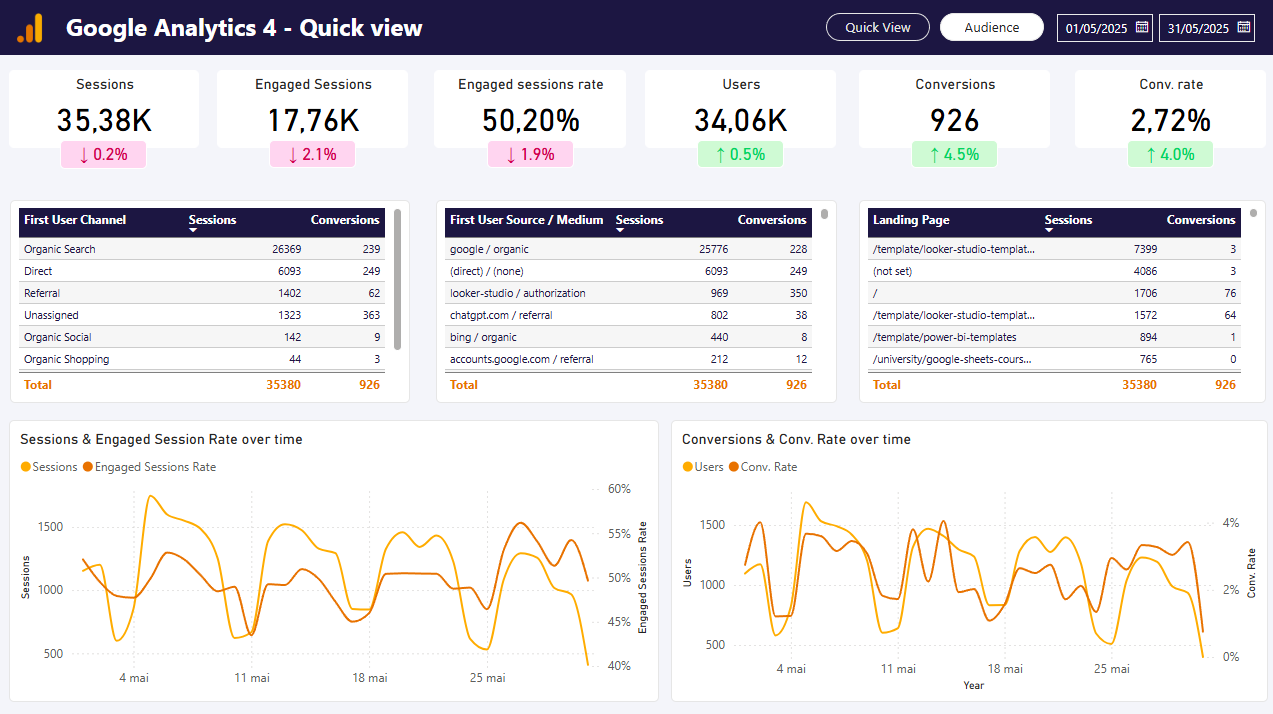Blog post
Catchr
Power BI
Google Analytics

The purpose of this tutorial is to guide marketers through the process of visualizing their marketing data by connecting Google Analytics to PowerBI through Catchr. By the end of this guide, you will have a complete understanding of how to seamlessly transfer data between these powerful tools and commence crafting insightful dashboards and reports.
Begin on Catchr's main dashboard and look for the "Sources" option within the side menu. Once there, simply click "Add a Source" found in the upper-right area of the interface.

Afterwards, select "Google Analytics" as your desired platform and follow the prompts to authenticate and establish a link between Catchr and your Google Analytics account.
Here's how you can organize your data export directly into PowerBI:












PowerBI Desktop
To bring your Google Analytics data into PowerBI Desktop, employ a web data source:


PowerBI will then process and load your data, which can take a short while. Soon after, you'll have the freedom to use PowerBI Query for editing, and begin constructing your customized dashboards. Upon finalizing your dashboards, go ahead with publishing and sharing them with your desired audience.
PowerBI Web App
For web app users, following the desktop publishing steps is necessary initially. Once your data set is in the PowerBI Web App, start a new report and make your selection from the already-published datasets for further report creation.
In conclusion, successfully transferring your data from Google Analytics into PowerBI is an invaluable asset offering a holistic view of marketing performance across all channels. Whether you're a data analyst, marketer, or business owner, the integration empowers you with actionable insights to drive strategic decisions and optimize campaigns.
Google Analytics offers a wealth of metrics ideal for PowerBI visualization. By using PowerBI, you can track everything from simple pageviews to complex conversion paths, assessing real-time campaign effectiveness or historical trends over time. Metrics such as user engagement, e-commerce transactions, or ad performance are among the many you can import into PowerBI via the Catchr service, enabling you to identify patterns, understand user behavior, and calculate return on investment (ROI).
For example, you might create a dashboard that overlays advertising spend from AdWords with e-commerce revenue, gaining insights into which campaigns yield the best ROI. Alternatively, with the engagement metrics, you can build visualizations that showcase the most engaging content on your site, helping content creators and marketers to replicate successful strategies.
Additional metrics, such as Device category and Browser, help in understanding user demographics and preferences, enabling marketers to tailor experiences to different segments. Data from Google Analytics can be combined with other data sources in PowerBI for even richer insights.
For an extensive list of the available Google Analytics metrics that can be leveraged within PowerBI, please visit Catchr's fields listing.
Start using Looker Studio with a ready-to-use template
Get the template
Start analyzing your data with a Looker Studio template
Catchr provides free dashboard templates to help you start analyzing your data on Looker Studio — 100+ available templates!
See all the Looker Studio templatesStart using Power BI with a ready-to-use template
Get the template
Start analyzing your data with a Power BI template
Catchr provides free dashboard templates to help you start analyzing your data on Power BI — 20+ available templates!
See all the Power BI templatesStart using Google Sheets with a ready-to-use template
Get the template
Start analyzing your data with a Google Sheets template
Catchr provides free dashboard templates to help you start analyzing your data on Google Sheets — 20+ available templates!
See all the Google Sheets templates✔ 14 days free trial — No credit-card required


✔ 14 days free trial — No credit-card required
Move your Marketing data to your favorite tools
Simplify your data extraction and move all your Marketing data to dashboard tools, spreadsheets, database and more... No code required!
75+ connectors | 20+ destinations
✔ 14 days free trial — No credit-card required

